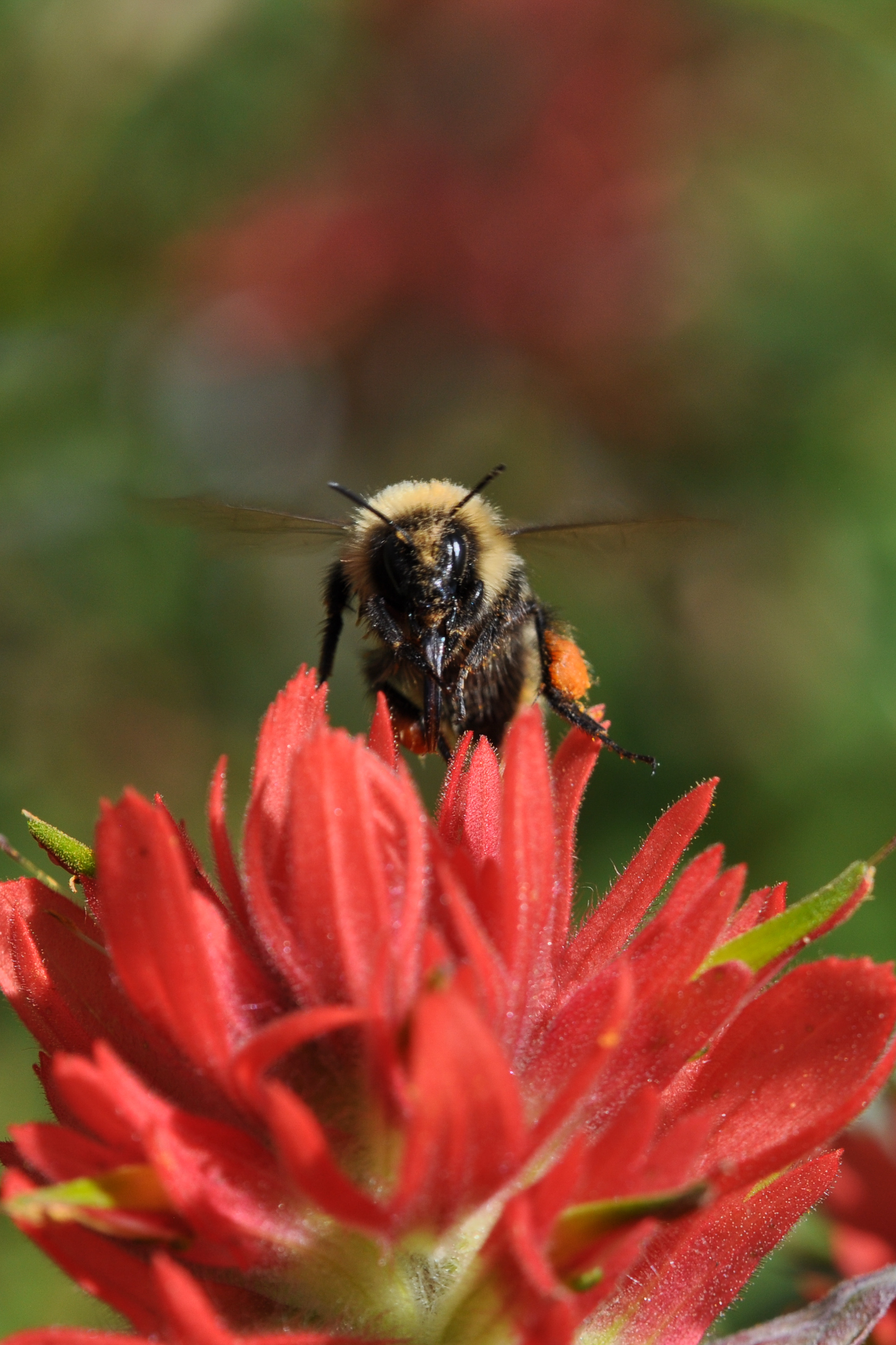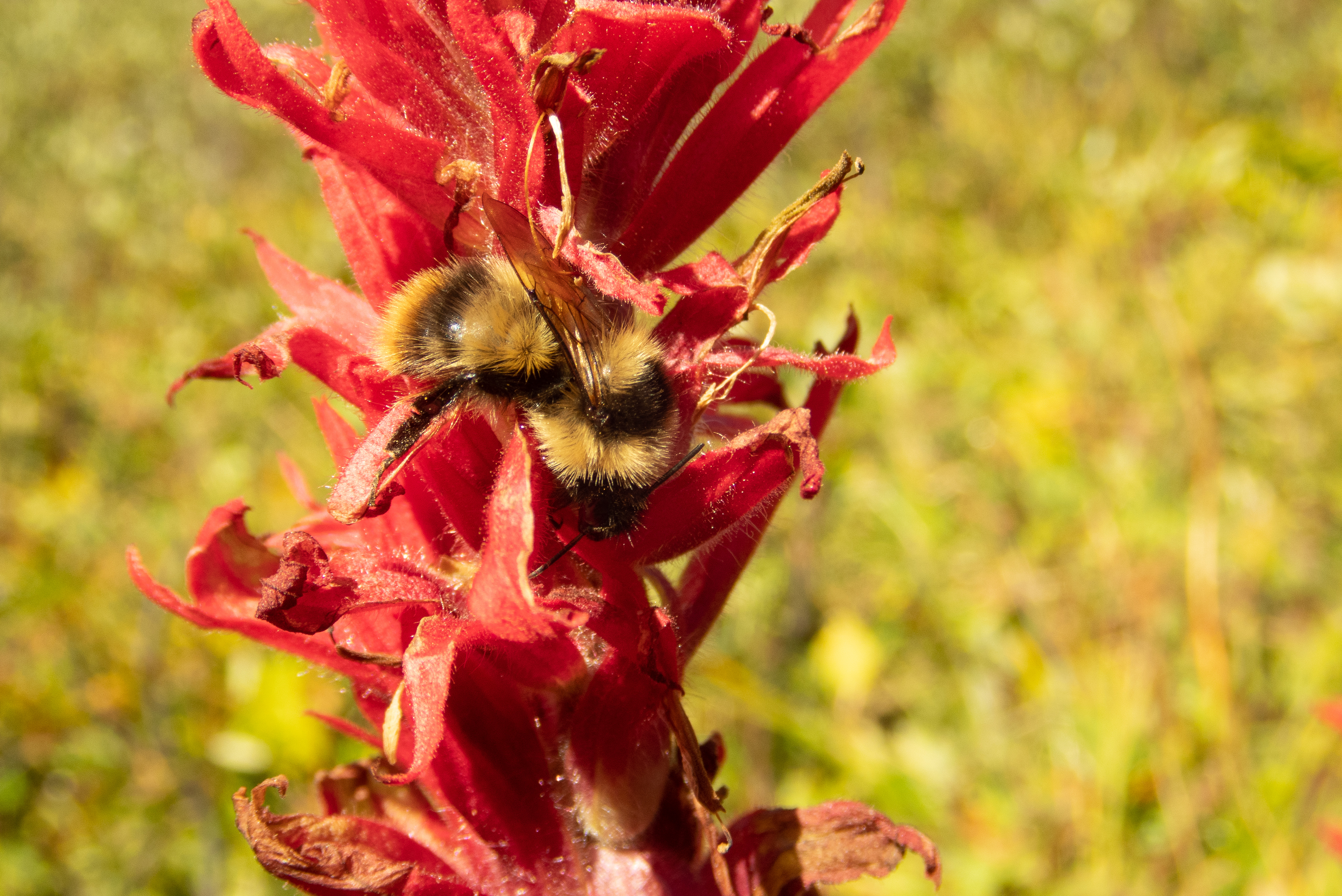Rich Hatfield, senior endangered species conservation biologist and bumble bee lead for the Xerces Society, trekked into Washington state’s Pasayten Wilderness to find the elusive high country bumble bee (Bombus kirbiellus).
As the Red List Authority for the International Union for the Conservation of Nature Bumble Bee Specialist Group (IUCN BBSG), I often read the names of bumble bees from remote areas of the globe that I’ve never had the opportunity to lay eyes on—at least in person. So I was intrigued last year when I got an email from Don Rolfs—a retired periodontist based in Wenatchee, Washington that has dedicated the last 15 or so years of his life to learning about and documenting the native bees of Washington—and his colleague Lisa Robinson—a naturalist and budding bumble bee expert—about an unusual sighting in northern Washington. Don and his friend David Jennings—President of the Washington Butterfly Association—had determined a location where alpine bumble bees (and other interesting native bees) might be found, and came home with the observation that was shared with me. (We are lucky in this part of the world to have so many people that care about our wonderful native bees!)
From photos, the 2017 sighting near Wenatchee looked like the high country bumble bee, Bombus kirbiellus—a northern latitude, high elevation species, known most commonly from Alaska down the spine of the Rocky Mountains, and in a small enclave in the Sierra Nevada. The observation added to a small handful of records of this species from Washington State. Was it possible that this species could also call the Pacific Northwest home? For personal interest, and as part of the Pacific Northwest Bumble Bee Atlas (PNWBBA), I had to find out. I set about planning an expedition for August of 2019.
My destination, which was nearly on the Canadian border, promised a glimpse of the vast alpine tundra that extends to the north. I was going to be trekking through a set of high elevation plateaus in the Pasayten Wilderness in northern Washington, east of North Cascades National Park. I was joined by Kevin Schafer, a retired professional photographer from Seattle and tireless volunteer for the PNWBBA. We met on a Friday evening in a small town in the Okanogan Valley to begin the journey. An hour later, we were pulling into the trailhead at last light, where we set up camp for the night. Cold temperatures and light sprinkles chased us into the tent and left us wondering if there were going to be enough flowers left in the high country for a successful search. We’d have our answer soon enough…
We woke the next morning to cold, mostly clear weather. We packed our bags while we chatted with some other folks at the trailhead. We learned we weren’t the only ones heading out in search of wildlife that day—bear hunting season had already started in this area. Our insect nets and plastic vials may have set us apart from the hunters, but it was clear we shared a mutual respect and interest for tracking animals in the wilderness.

We spent the bulk of the morning hiking through the scars of the 2006 Tripod Fire that, at the time, was one of the largest wildfires in the history of Washington state. We saw signs of moose and deer, and hiked past stands of lupine and fireweed that offered a glimpse of might lie ahead—flowers and bees! About halfway to our destination, we emerged from the recovering landscape into a sloped alpine meadow, full of flowers: Lupine, penstemon, red paintbrush, Parry’s silene, fireweed, and asters were everywhere—the search was on!
The temperatures were still cool, likely in the low 50s, and there was significant cloud cover, so bee activity was low. We found some males that had likely spent the night clinging to vegetation, but other sightings were sparse. We reluctantly put our packs back on, and headed up the trail, deciding to return to this site in two days, on our way out.
As we neared the far end of the meadow, the sun peeked out of the clouds—and bumble bee activity almost instantly picked up. With my pack on, I noticed a bee doing something I’d not seen many bumble bees do before. It was flying from red paintbrush (Castilleja sp.) to red paintbrush—which I’d previously considered to be a marginal bumble bee plant! I scooped the bee into my net for a closer look.
Once transferred to a plastic vial, I quickly recognized that this might be a bee I’d never seen before. It had the familiar orange rump of a fuzzy horned bumble bee (Bombus mixtus), but it had a combination of features I’d not seen together. Its face was black, and it clearly had a long cheek (malar space).
Surely the first bee I really looked at couldn’t be…could it? It was! There, in the flesh, was my first live member of the subgenus Alpinobombus, the high country bumble bee (Bombus kirbiellus).

We instantly conducted a survey using the PNWBBA protocol, and for the first time documented the high country bumble bee in the PNWBBA, bumping the number of species documented throughout the course of the Atlas from 22 to 23.*
Throughout the rest of our time in the Pasayten Wilderness, we found the high country bumble bee at several locations. We were able to photograph the bee while it was foraging, and observe it as it moved through the tundra-like landscape—which was vastly different from what lay to the east, west and south. This species’ flower selection was unique, too: While most other bees crowded the asters that blanketed the hillsides, the high country bumble bee seemed to have all of the red paintbrush to itself. We also saw a queen, and some males—the latter among the asters with two form bumble bees (Bombus bifarius) and black tail bumble bees (Bombus melanopygus); females were always found on red paintbrush.
Interestingly, during the weekend I pulled out my copy of Bumble Bees of North America by Williams, Thorp, Richardson and Colla and there it was in black and white: Bombus kirbliellus’ #1 preferred food plant is Castilleja sp. (red paintbrush)—agreed! (The book actually lists the bumble bee as Bombus balteatus, because the name recently changed as the North American group was separated from its European counterpart using DNA evidence.)
Our exciting discoveries were not over. On one creekside survey we also saw two individuals of another high elevation, high latitude species that had not yet shown up in PNWBBA surveys (and that I had never seen), the frigid bumble bee (Bombus frigidus). These were males, and much harder to confidently ID in the field, but I took one specimen home for verification, and was able to positively ID it as a frigid bumble bee. The number of species in the PNWBBA was now 24!

When all was said and done, we had observed ten species in two days of surveys:
- Bombus appositus - the white shouldered bumble bee
- Bombus bifarius - the two form bumble bee
- Bombus flavidus - Fernald’s cuckoo bumble bee
- Bombus flavifrons - the yellow head bumble bee
- Bombus frigidus - the frigid bumble bee
- Bombus insularis - the indiscriminant cuckoo bumble bee
- Bombus kirbiellus - the high country bumble bee
- Bombus melanopygus - the black tailed bumble bee
- Bombus mixtus - the fuzzy horned bumble bee
- Bombus sylvicola - the forest bumble bee
It was a spectacular journey, full of the joys of discovery and serving as a brief reminder that parts of our wonderful world are still wild, largely undiscovered, and (at least partially) insulated against much of the tumultuous change that has occurred and surely lies ahead. I admired the foresight many conservation leaders had in setting large swaths of the American west aside as protected Wildernesses and National Parks. And, if only for a brief moment, I was able to wonder if it was possible for nature to endure in the face of the pressures humanity is applying.
Now that I have returned from the Pasayten Wilderness, I am still left with some of that hope and wonder—because the healing power of wilderness is lasting. However, I also recognize that it is possible that the existence of those two alpine bumble bee species in the state of Washington, though recently discovered, may nearly be past. As the climate changes, the vast expanse of British Columbia—only a few short miles to the north—may soon be the only suitable habitat for some of the sensitive plants and animals that call the Pasayten Wilderness home.
As the climate changes, the vast expanse of British Columbia—only a few short miles to the north—may soon be the only suitable habitat for some of the sensitive plants and animals that call the Pasayten Wilderness home.
At the time, setting aside large tracts of land showed incredible foresight in terms of environmental and species conservation—but the future has arrived, and there is much more to do. Protecting habitat from development was an important first step, but we’ve had the knowledge that climate change was coming for over thirty years and have not yet taken action at a scale sufficient to slow its advance.
The Pacific Northwest Bumble Bee Atlas is making strides in the right direction—engaging over 600 people throughout Oregon, Washington and Idaho in bumble bee conservation in a span of two years. But, even 600 people working together cannot recreate the conditions for arctic tundra, nor slow the pace of a changing climate. That will take the courage of political and business leaders far beyond our circle to acknowledge our collective role and responsibility in sustaining a habitable planet—for ALL species, no matter how small or nondescript.
Earlier this month, I saw two species of bumble bee that are teetering on the brink of their existence in the lower 48 states, clinging to a tongue of fragile alpine habitat that extends from the north. Are we brave enough to value their existence as much as our own? The winds of change are blowing, and for now I’ll hold on to hope that the future is brighter than the present. No matter what’s ahead, I will return to the Pasayten Wilderness to check on these two beautiful bumble bees in the hope that they—along with my hope and wonder—can persist.
*Still notably missing from the Atlas are two species of bumble bees, Franklin’s bumble bee (Bombus franklini)—which was recently proposed to be added to the Endangered Species Act—and the Suckley Cuckoo bumble bee (Bombus suckleyi), which has rarely been observed since 2000, despite its large historic range.
This project was made possible due, in part, to funding from the Interagency Special Status/Sensitive Species Program.
Further Reading
Learn more about the Pacific Northwest Bumble Bee Atlas.
Read about the Xerces Society’s Endangered Species Conservation Program.
Read our recent Climate News Round-Up for an actionable step we can all take to slow climate change.




